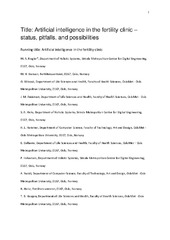| dc.contributor.author | Riegler, Michael Alexander | |
| dc.contributor.author | Stensen, Mette Haug | |
| dc.contributor.author | Witczak, Oliwia | |
| dc.contributor.author | Andersen, Jorunn Marie | |
| dc.contributor.author | Hicks, Steven | |
| dc.contributor.author | Hammer, Hugo Lewi | |
| dc.contributor.author | Delbarre, Erwan | |
| dc.contributor.author | Halvorsen, Pål | |
| dc.contributor.author | Yazidi, Anis | |
| dc.contributor.author | Holst, Nicolai | |
| dc.contributor.author | Haugen, Trine B. | |
| dc.date.accessioned | 2022-02-08T14:55:41Z | |
| dc.date.available | 2022-02-08T14:55:41Z | |
| dc.date.issued | 2021-07-29 | |
| dc.description.abstract | In recent years, the amount of data produced in the field of ART has increased exponentially. The diversity of data is large, ranging from videos to tabular data. At the same time, artificial intelligence (AI) is progressively used in medical practice and may become a promising tool to improve success rates with ART. AI models may compensate for the lack of objectivity in several critical procedures in fertility clinics, especially embryo and sperm assessments. Various models have been developed, and even though several of them show promising performance, there are still many challenges to overcome. In this review, we present recent research on AI in the context of ART. We discuss the strengths and weaknesses of the presented methods, especially regarding clinical relevance. We also address the pitfalls hampering successful use of AI in the clinic and discuss future possibilities and important aspects to make AI truly useful for ART. | en_US |
| dc.description | This is a pre-copyedited, author-produced version of an article accepted for publication in <i>Human Reproduction</i> following peer review. The version of record Riegler, Stensen, Witczak, Andersen, Hicks, Hammer, Delbarre, Halvorsen, Yazidi, Holst, Haugen. Artificial intelligence in the fertility clinic: status, pitfalls and possibilities. Human Reproduction. 2021 is available online at: <a href=https://doi.org/10.1093/humrep/deab168>https://doi.org/10.1093/humrep/deab168</a>. | en_US |
| dc.identifier.citation | Riegler, Stensen, Witczak, Andersen, Hicks, Hammer, Delbarre, Halvorsen, Yazidi, Holst, Haugen. Artificial intelligence in the fertility clinic: status, pitfalls and possibilities. Human Reproduction. 2021 | en_US |
| dc.identifier.cristinID | FRIDAID 1952194 | |
| dc.identifier.doi | 10.1093/humrep/deab168 | |
| dc.identifier.issn | 0268-1161 | |
| dc.identifier.issn | 1460-2350 | |
| dc.identifier.uri | https://hdl.handle.net/10037/23966 | |
| dc.language.iso | eng | en_US |
| dc.publisher | Oxford University Press | en_US |
| dc.relation.journal | Human Reproduction | |
| dc.rights.accessRights | openAccess | en_US |
| dc.rights.holder | Copyright 2021 The Author(s) | en_US |
| dc.title | Artificial intelligence in the fertility clinic: status, pitfalls and possibilities | en_US |
| dc.type.version | acceptedVersion | en_US |
| dc.type | Journal article | en_US |
| dc.type | Tidsskriftartikkel | en_US |
| dc.type | Peer reviewed | en_US |


 English
English norsk
norsk